Accessing the Difference in the Climate Elasticity of Runoff across the Poyang Lake Basin, China
Abstract
:1. Introduction
2. Study Area and Data Preparation
2.1. Overview of the Poyang Lake Basin
2.2. Data Preparation
3. Methodology
3.1. Trend Analysis for Hydro-Meteorological Variables
3.1.1. Mann–Kendall Test
3.1.2. Sen’s Slope Estimator
3.2. Calibration of the Catchment Properties Parameter
3.3. Derivation of Climate Elasticity
3.4. Runoff Prediction with Climate Elasticity
4. Results
4.1. Trend in Climatic and Hydrologic Variables
4.2. Temporal and Spatial Pattern of the Catchment Properties’ Parameter
4.3. Climatic Elasticity in PYLB
4.4. Influence of the Catchment Properties’ Parameter on Climate Elasticities and Runoff Prediction
5. Discussion
5.1. Potential Factors Influencing the Catchment Properties’ Parameter
5.2. Uncertainty and the Limitations of This Study
6. Conclusions
- Changes in climatic variables and runoff were found using the Mann–Kendall test and Sen’s slope estimator. Annual temperature in PYLB significantly increased at a rate of 1.44% (i.e., 0.19 °C) per decade. Basin-wide wind speed (U) and net radiation () had been declining at 0.17 m/s and 46.30 MJ/m2 per decade. No significant trend was detected in precipitation and relative humidity.
- The catchment properties’ parameter is not constant during the whole study period. As we evaluated, in sub-basins, except for the Fuhe, a slight upward trend can be found during 1970–1980, followed by a decrease trend in the period from 1980 to 1990. However, the n value in Fuhe sub-basin kept increasing for the period from 1970 to 2010, which is almost persistent for the whole study period. In addition, the derived climate elasticities were significantly correlated with the catchment properties’ parameter, indicating that the catchment properties’ parameter was the dominant factor influencing climate elasticity in PYLB in the past 50 years.
- The moving window method presented in this study is relatively simple, but it is a feasible method to detect the temporal variation of climate elasticity and catchment properties. Taking the variation of the catchment properties’ parameter into consideration when predicting future runoff may enhance the accuracy.
Acknowledgments
Author Contributions
Conflicts of Interest
References
- Intergovernmental Panel on Climate Change. Climate Change; Intergovernmental Panel on Climate Change: Geneva, Switzerland, 2001. [Google Scholar]
- Solomon, S. Climate Change 2007—The Physical Science Basis: Working Group I Contribution to the Fourth Assessment Report of the IPCC; Cambridge University Press: Cambridge, UK, 2007; Volume 4. [Google Scholar]
- Yang, H.B.; Yang, D.W. Derivation of climate elasticity of runoff to assess the effects of climate change on annual runoff. Water Resour. Res. 2011, 47. [Google Scholar] [CrossRef]
- Donohue, R.J.; Roderick, M.L.; McVicar, T.R. Assessing the differences in sensitivities of runoff to changes in climatic conditions across a large basin. J. Hydrol. 2011, 406, 234–244. [Google Scholar] [CrossRef]
- Milly, P.C.D.; Dunne, K.A. Macroscale water fluxes—2. Water and energy supply control of their interannual variability. Water Resour. Res. 2002, 38. [Google Scholar] [CrossRef]
- Sankarasubramanian, A.; Vogel, R.M.; Limbrunner, J.F. Climate elasticity of streamflow in the United States. Water Resour. Res. 2001, 37, 1771–1781. [Google Scholar] [CrossRef]
- Kundzewicz, Z.W.; Stakhiv, E.Z. Are climate models “ready for prime time” in water resources management applications, or is more research needed? Hydrol. Sci. J. 2010, 55, 1085–1089. [Google Scholar] [CrossRef]
- Fu, B. On the calculation of the evaporation from land surface. Sci. Atmos. Sin. 1981, 5, 23–31. [Google Scholar]
- Dooge, J.; Bruen, M.; Parmentier, B. A simple model for estimating the sensitivity of runoff to long-term changes in precipitation without a change in vegetation. Adv. Water Resour. 1999, 23, 153–163. [Google Scholar] [CrossRef]
- Nash, L.L.; Gleick, P.H. Sensitivity of streamflow in the Colorado basin to climatic changes. J. Hydrol. 1991, 125, 221–241. [Google Scholar] [CrossRef]
- Revelle, R.R.; Waggoner, P.E. Effects of a Carbon Dioxide-Induced Climatic Change on Water Supplies in 7 the Western United States. Month 1983, 419, 432. [Google Scholar]
- Schaake, J.C.; Waggoner, P. From climate to flow. In Climate Change and US Water Resources; John Wiley & Sons: Hoboken, NJ, USA, 1990; pp. 177–206. [Google Scholar]
- Vogel, R.M.; Wilson, I.; Daly, C. Regional regression models of annual streamflow for the United States. J. Irrig. Drain. Eng. 1999, 125, 148–157. [Google Scholar] [CrossRef]
- Milly, P.; Betancourt, J.; Falkenmark, M.; Hirsch, R.; Kundzewicz, Z.; Lettenmaier, D.; Stouffer, R. Climate change. Stationarity is dead: whither water management? Science 2008, 319, 573–574. [Google Scholar] [CrossRef] [PubMed]
- Budyko, M. Climate and Life, 508 pp; Academic Press: San Diego, CA, USA, 1974; pp. 72–191. [Google Scholar]
- Yang, H.; Yang, D.; Lei, Z.; Sun, F. New analytical derivation of the mean annual water-energy balance equation. Water Resour. Res. 2008, 44. [Google Scholar] [CrossRef]
- Trancoso, R.; Larsen, J.R.; Mcalpine, C.; Mcvicar, T.R.; Phinn, S. Linking the Budyko framework and the Dunne diagram. J. Hydrol. 2016, 535, 581–597. [Google Scholar] [CrossRef]
- Roderick, M.L.; Farquhar, G.D. A simple framework for relating variations in runoff to variations in climatic conditions and catchment properties. Water Resour. Res. 2011, 47. [Google Scholar] [CrossRef]
- Yang, D.; Shao, W.; Yeh, P.J.F.; Yang, H.; Kanae, S.; Oki, T. Impact of vegetation coverage on regional water balance in the nonhumid regions of China. Water Resour. Res. 2009, 45, 450–455. [Google Scholar] [CrossRef]
- Cong, Z.; Zhang, X.; Li, D.; Yang, H.; Yang, D. Understanding Hydrological Trends by Combining the Budyko Hypothesis and a Stochastic Soil Moisture Model. Hydrol. Sci. J. 2014, 60, 145–155. [Google Scholar] [CrossRef]
- Yang, D.; Sun, F.; Liu, Z.; Cong, Z.; Lei, Z. Interpreting the complementary relationship in non-humid environments based on the Budyko and Penman hypotheses. Geophys. Res. Lett. 2006, 33, 122–140. [Google Scholar] [CrossRef]
- Yang, D.; Sun, F.; Liu, Z.; Cong, Z.; Ni, G.; Lei, Z. Analyzing spatial and temporal variability of annual water-energy balance in nonhumid regions of China using the Budyko hypothesis. Water Resour. Res. 2007, 43, 436–451. [Google Scholar] [CrossRef]
- Zheng, H.; Lu, Z.; Zhu, R.; Liu, C.; Sato, Y.; Fukushima, Y. Responses of streamflow to climate and land surface change in the headwaters of the Yellow River Basin. Water Resour. Res. 2009, 45, 641–648. [Google Scholar] [CrossRef]
- Arora, V.K. The use of the aridity index to assess climate change effect on annual runoff. J. Hydrol. 2002, 265, 164–177. [Google Scholar] [CrossRef]
- Gong, L.B.; Xu, C.Y.; Chen, D.L.; Halldin, S.; Chen, Y.Q.D. Sensitivity of the Penman-Monteith reference evapotranspiration to key climatic variables in the Changjiang (Yangtze River) basin. J. Hydrol. 2006, 329, 620–629. [Google Scholar] [CrossRef]
- Choudhury, B. Evaluation of an empirical equation for annual evaporation using field observations and results from a biophysical model. J. Hydrol. 1999, 216, 99–110. [Google Scholar] [CrossRef]
- Mezentsev, V. More on the calculation of average total evaporation. Meteorol. Gidrol. 1955, 5, 24–26. [Google Scholar]
- Penman, H.L. Natural evaporation from open water, bare soil and grass. Proc. R. Soc. Lond. Ser. A Math. Phys. Sci. 1948, 9, 120–145. [Google Scholar] [CrossRef]
- Donohue, R.J.; Roderick, M.L.; Mcvicar, T.R. Roots, storms and soil pores: Incorporating key ecohydrological processes into Budyko’s hydrological model. J. Hydrol. 2012, 436–437, 35–50. [Google Scholar] [CrossRef]
- CSIRO. Water Availability in the Murray-Darling Basin. A Report to the Australian Government from the CSIRO Murray-Darling Basin Sustainable Yields Project; Csiro Australia: Kawana, Australia, 2008.
- Donohue, R.J.; Mcvicar, T.R.; Roderick, M.L. Assessing the ability of potential evaporation formulations to capture the dynamics in evaporative demand within a changing climate. J. Hydrol. 2010, 386, 186–197. [Google Scholar] [CrossRef]
- Lei, S.; Zhang, X.P.; Li, R.F.; Xu, X.H.; Fu, Q. Analysis the changes of annual for Poyang Lake wetland vegetation based on MODIS monitoring. Procedia Environ. Sci. 2011, 10 Pt B, 1841–1846. [Google Scholar]
- Shankman, D.; Liang, Q. Landscape Changes and Increasing Flood Frequency in China’s Poyang Lake Region. Prof. Geogr. 2003, 55, 434–445. [Google Scholar] [CrossRef]
- Ye, X.C.; Zhang, Q.; Liu, J.; Li, X.H.; Xu, C.Y. Distinguishing the relative impacts of climate change and human activities on variation of streamflow in the Poyang Lake catchment, China. J. Hydrol. 2013, 494, 83–95. [Google Scholar] [CrossRef]
- Tan, Z.; Tao, H.; Jiang, J.; Zhang, Q. Influences of Climate Extremes on NDVI (Normalized Difference Vegetation Index) in the Poyang Lake Basin, China. Wetlands 2015, 35, 1033–1042. [Google Scholar] [CrossRef]
- Xu, L.G.; Zhu, M.L.; He, B.; Wang, X.L.; Zhang, Q.; Jiang, J.H.; Razafindrabe, B.H.N. Analysis of Water Balance in Poyang Lake Basin and Subsequent Response to Climate Change. J. Coast. Res. 2014, 68, 136–143. [Google Scholar] [CrossRef]
- Guo, H.; Hu, Q.; Jiang, T. Annual and seasonal streamflow responses to climate and land-cover changes in the Poyang Lake basin, China. J. Hydrol. 2008, 355, 106–122. [Google Scholar] [CrossRef]
- Dai, X.; Wan, R.; Yang, G. Non-stationary water-level fluctuation in China’s Poyang Lake and its interactions with Yangtze River. J. Geogr. Sci. 2015, 25, 274–288. [Google Scholar] [CrossRef]
- Zhu, H.; Zhang, B. Poyang Lake—Hydrology. In Biology. Deposition. Wetland. Exploitation and Rebuilding; University of Science and Technology of China Press: Hefei, China, 1997; pp. 146–233. [Google Scholar]
- Allen, R.G.; Pereira, L.S.; Raes, D.; Smith, M. Crop Evapotranspiration—Guidelines for Computing Crop Water Requirements—FAO Irrigation and Drainage Paper 56; Food and Agriculture Organization of the United Nations: Rome, Italy, 1998; Volume 300, p. D05109. [Google Scholar]
- Zhang, L.L.; Yin, J.X.; Jiang, Y.Z.; Wang, H. Relationship between the hydrological conditions and the distribution of vegetation communities within the Poyang Lake National Nature Reserve, China. Ecol. Inform. 2012, 11, 65–75. [Google Scholar] [CrossRef]
- Zhang, Q.; Li, L.; Wang, Y.G.; Werner, A.D.; Xin, P.; Jiang, T.; Barry, D.A. Has the Three-Gorges Dam made the Poyang Lake wetlands wetter and drier? Geophys. Res. Lett. 2012, 39. [Google Scholar] [CrossRef]
- Thiessen, A.H. Precipitation averages for large areas. Mon. Weather Rev. 1911, 39, 1082–1089. [Google Scholar] [CrossRef]
- Mann, H.B. Nonparametric Tests Against Trend. Econometrica 1945, 13, 245–259. [Google Scholar] [CrossRef]
- Sen, Z. Probabilistic formulation of spatio-temporal drought pattern. Theor. Appl. Climatol. 1998, 61, 197–206. [Google Scholar]
- Rousseeuw, P.J.; Leroy, A.M. Robust Regression and Outlier Detection; Wiley-Interscience: Hoboken, NJ, USA, 1987; pp. 260–261. [Google Scholar]
- Bagrov, N. Mean long-term evaporation from land surface. Meteorol. Gidrol. 1953, 10, 21–30. [Google Scholar]
- Soetaert, K.; Herman, P.M.J. (Eds.) A Practical Guide to Ecological Modelling: Using R as a Simulation Platform; Springer: Berlin/Heidelberg, Germany, 2009.
- Schaake, J.; Liu, C. Development and application of simple water balance models to understand the relationship between climate and water resources. In Proceedings of the Baltimore Symposium—New Directions for Surface Water Modeling, Baltimore, MD, USA, 15–17 May 1989.
- R Development Core Team. R: A Language and Environment for Statistical Computing; R Foundation for Statistical Computing: Vienna, Austria, 2016. [Google Scholar]
- Yang, H.; Qi, J.; Xu, X.; Yang, D.; Lv, H. The regional variation in climate elasticity and climate contribution to runoff across China. J. Hydrol. 2014, 517, 607–616. [Google Scholar] [CrossRef]
- Zhang, D.; Liu, X.; Zhang, Q.; Liang, K.; Liu, C. Investigation of factors affecting intra-annual variability of evapotranspiration and streamflow under different climate conditions. J. Hydrol. 2016, 543, 759–769. [Google Scholar] [CrossRef]
- Berghuijs, W.R.; Woods, R.A. Correspondence: Space-time asymmetry undermines water yield assessment. Nat. Commun. 2016, 7, 11603. [Google Scholar] [CrossRef] [PubMed]
- Liu, M.; Xu, X.; Wang, D.; Sun, A.Y.; Wang, K. Karst catchments exhibited higher degradation stress from climate change than the non-karst catchments in southwest China: An ecohydrological perspective. J. Hydrol. 2016, 535, 173–180. [Google Scholar] [CrossRef]
- Li, D.; Pan, M.; Cong, Z.; Zhang, L.; Wood, E. Vegetation control on water and energy balance within the Budyko framework. Water Resour. Res. 2013, 49. [Google Scholar] [CrossRef]
- Wang, X.L.; Han, J.Y.; Xu, L.G.; Wan, R.R.; Chen, Y.W. Soil Characteristics in Relation to Vegetation Communities in the Wetlands of Poyang Lake, China. Wetlands 2014, 34, 829–839. [Google Scholar]
- China Statistics Press. Jiangxi Statistical Yearbook; China Statistics Press: Beijing, China, 2016. (In Chinese) [Google Scholar]
- Zhu, F.F.; Cheng, Q.Z. Spatial-temporal changes of NDVI and their relations with climate factors in Poyang Lake valley. Acta Agric. Jiangxi 2012, 24, 98–102. [Google Scholar]
- Piao, S.; Fang, J.; Zhou, L.; Guo, Q.; Henderson, M.; Ji, W.; Li, Y.; Tao, S. Interannual variations of monthly and seasonal normalized difference vegetation index (NDVI) in China from 1982 to 1999. J. Geophys. Res. Atmos. 2003, 108. [Google Scholar] [CrossRef]
- Mcvicar, T.R.; Li, L.T.; van Niel, T.G.; Zhang, L.; Li, R.; Yang, Q.K.; Zhang, X.P.; Mu, X.M.; Wen, Z.M.; Liu, W.Z. Developing a decision support tool for China’s re-vegetation program: Simulating regional impacts of afforestation on average annual streamflow in the Loess Plateau. For. Ecol. Manag. 2007, 251, 65–81. [Google Scholar] [CrossRef]
- Liu, Q.; Mcvicar, T.R. Assessing climate change induced modification of Penman potential evaporation and runoff sensitivity in a large water-limited basin. J. Hydrol. 2012, 464–465, 352–362. [Google Scholar] [CrossRef]
- Donohue, R.J.; Roderick, M.L.; Mcvicar, T.R.; Farquhar, G.D. Impact of CO2 fertilization on maximum foliage cover across the globe’s warm, arid environments. Geophys. Res. Lett. 2013, 40, 3031–3035. [Google Scholar] [CrossRef]
- Bond, W.J.; Midgley, G.F. Carbon dioxide and the uneasy interactions of trees and savannah grasses. Philos. Trans. R. Soc. Lond. 2012, 367, 601–612. [Google Scholar] [CrossRef] [PubMed]
- Iversen, C.M. Digging deeper: fine-root responses to rising atmospheric CO2 concentration in forested ecosystems. New Phytol. 2010, 186, 346–357. [Google Scholar] [CrossRef] [PubMed]
- Zuazo, V.H.D. Soil-erosion and runoff prevention by plant covers. A review. Agron. Sustain. Dev. 2008, 28, 65–86. [Google Scholar] [CrossRef]
- Sun, S.L.; Chen, H.S.; Ju, W.M.; Song, J.; Zhang, H.; Sun, J.; Fang, Y.J. Effects of climate change on annual streamflow using climate elasticity in Poyang Lake Basin, China. Theor. Appl. Climatol. 2013, 112, 169–183. [Google Scholar] [CrossRef]

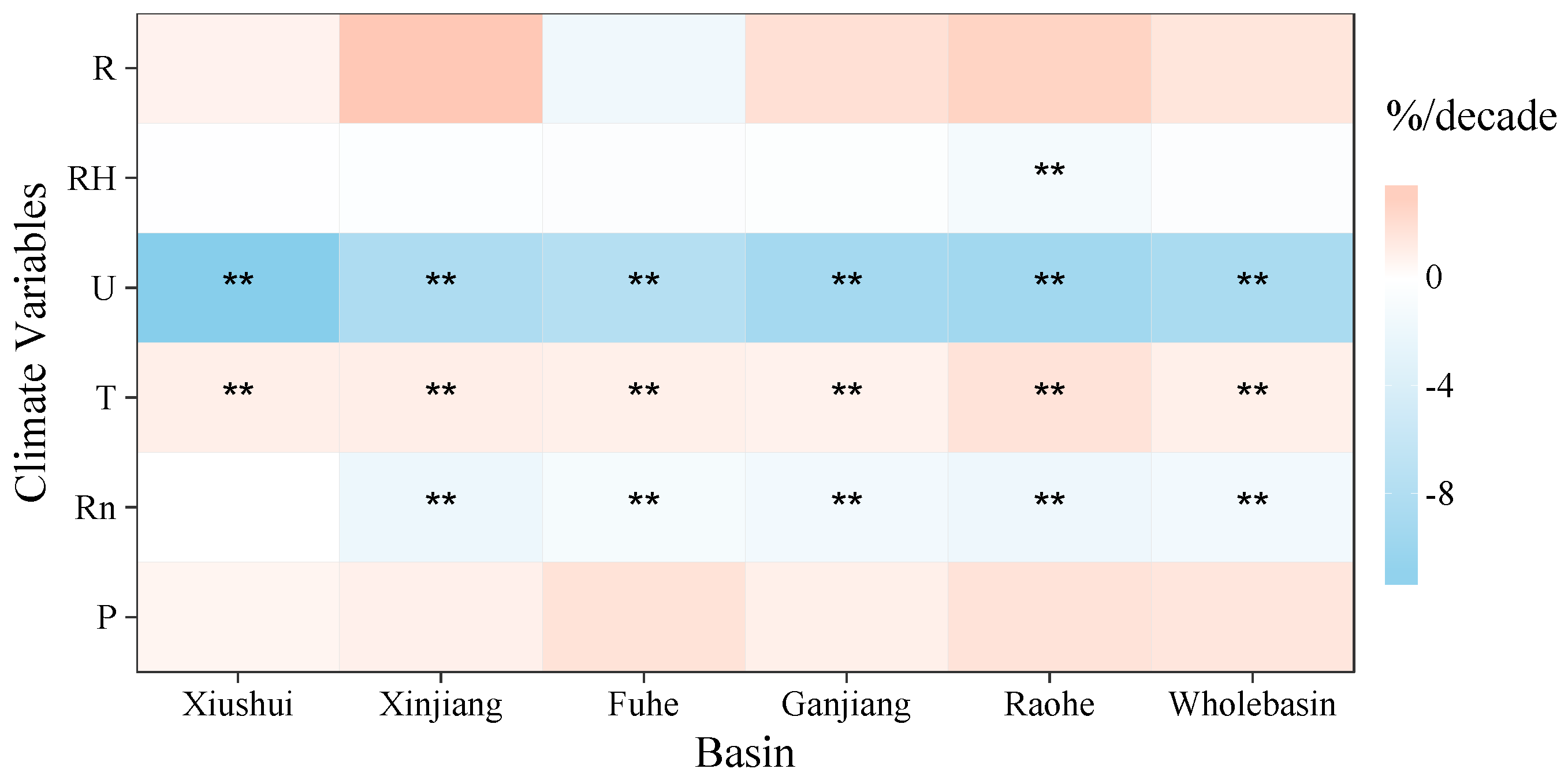
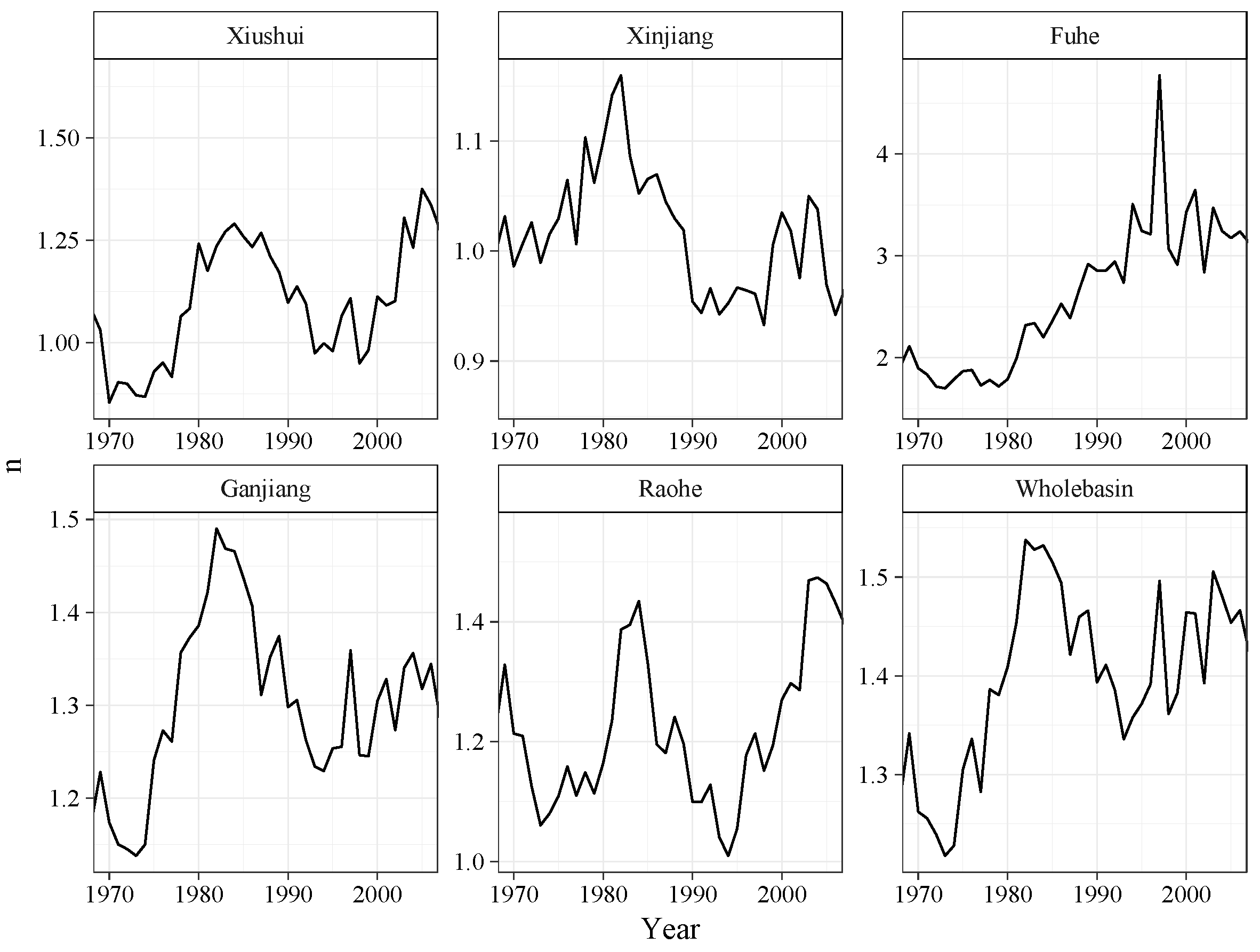
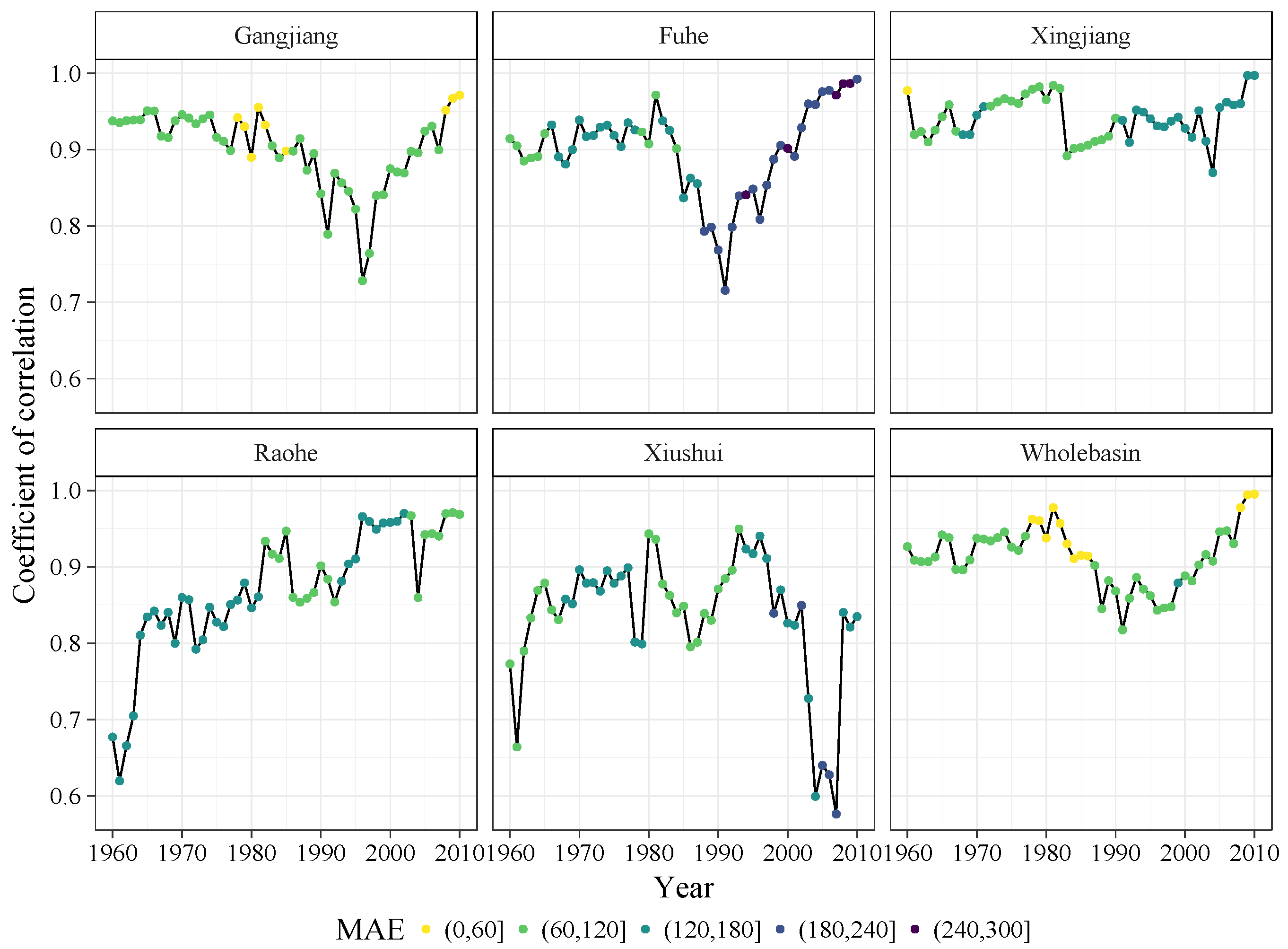
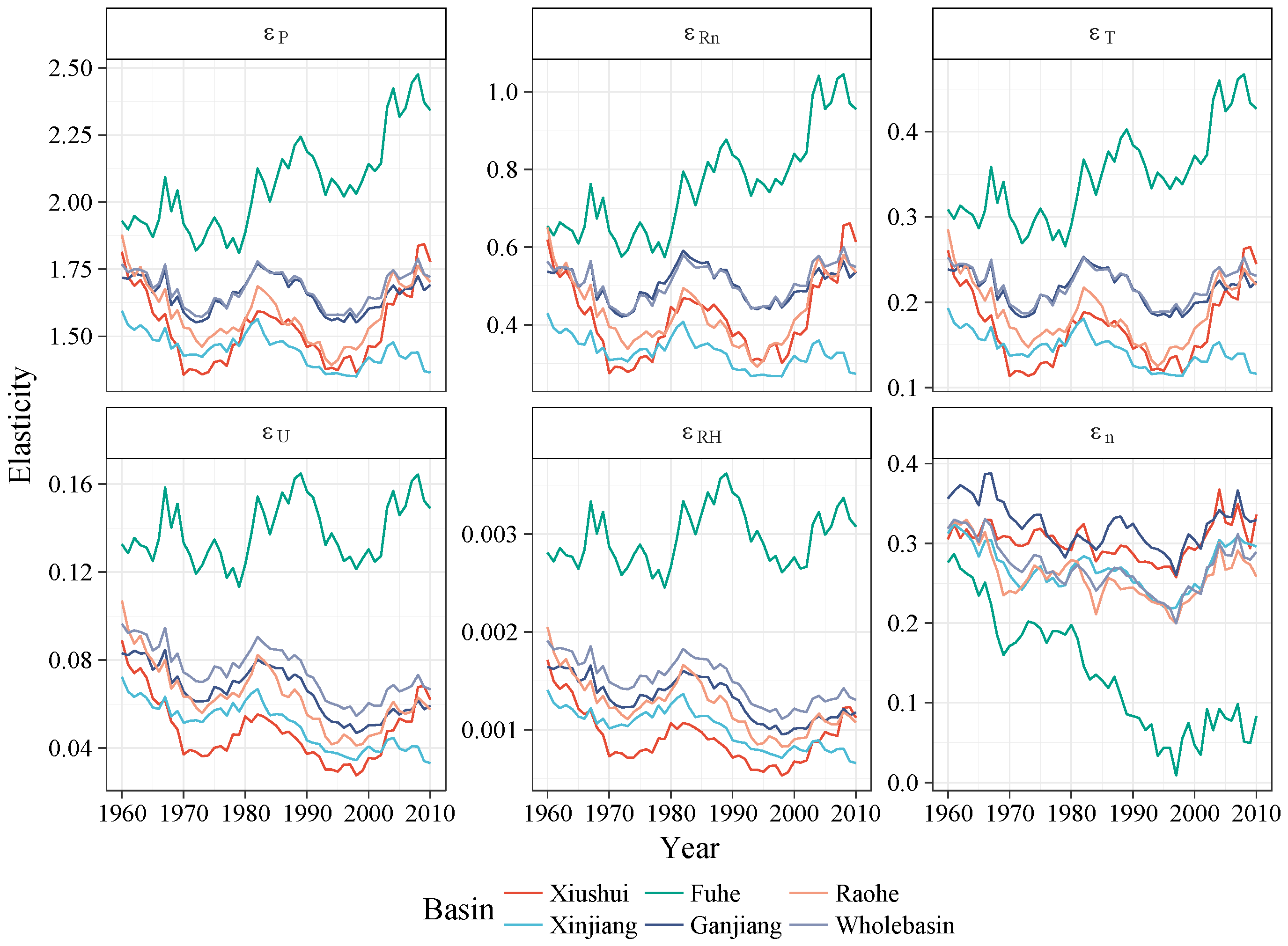
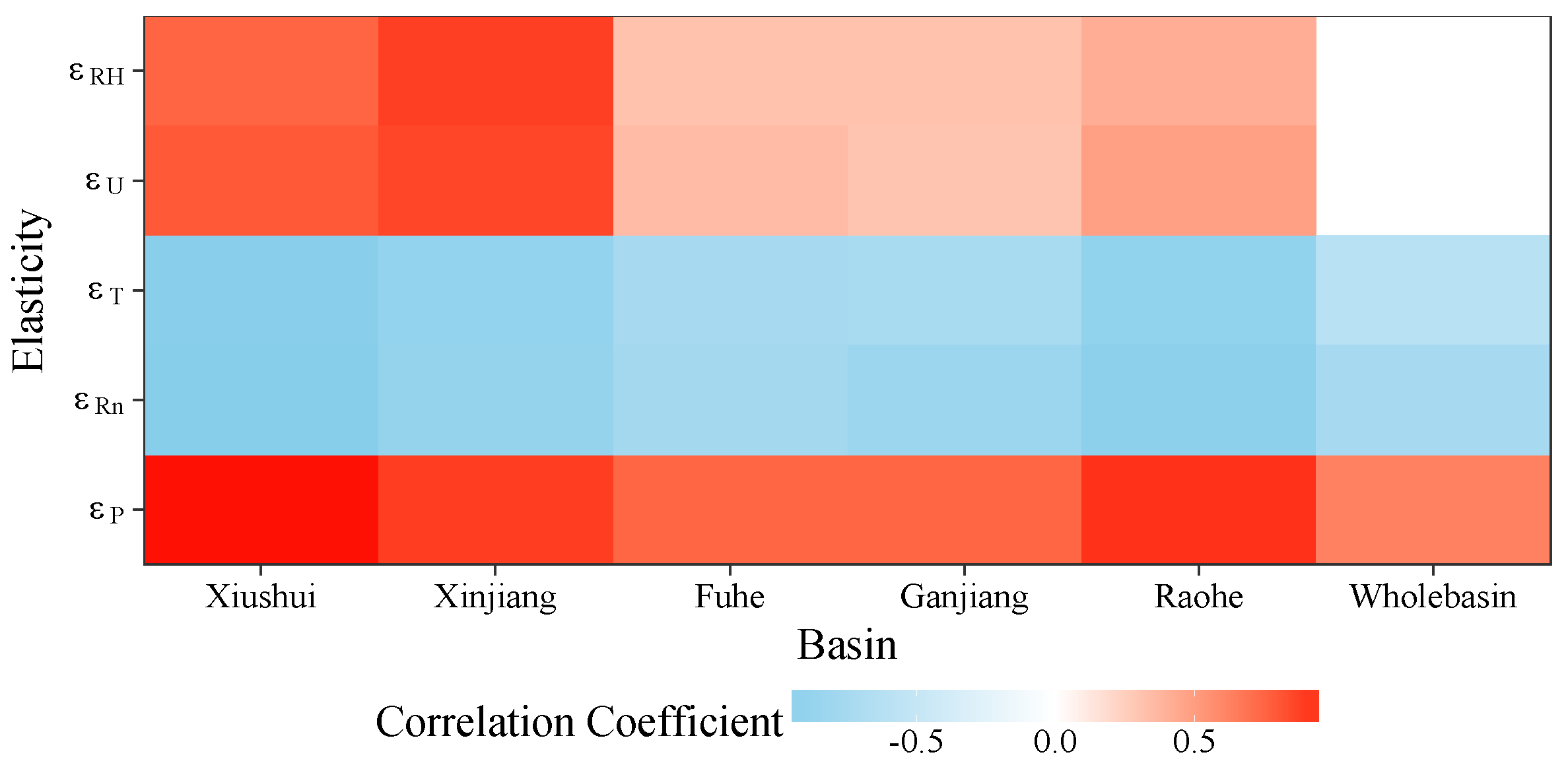
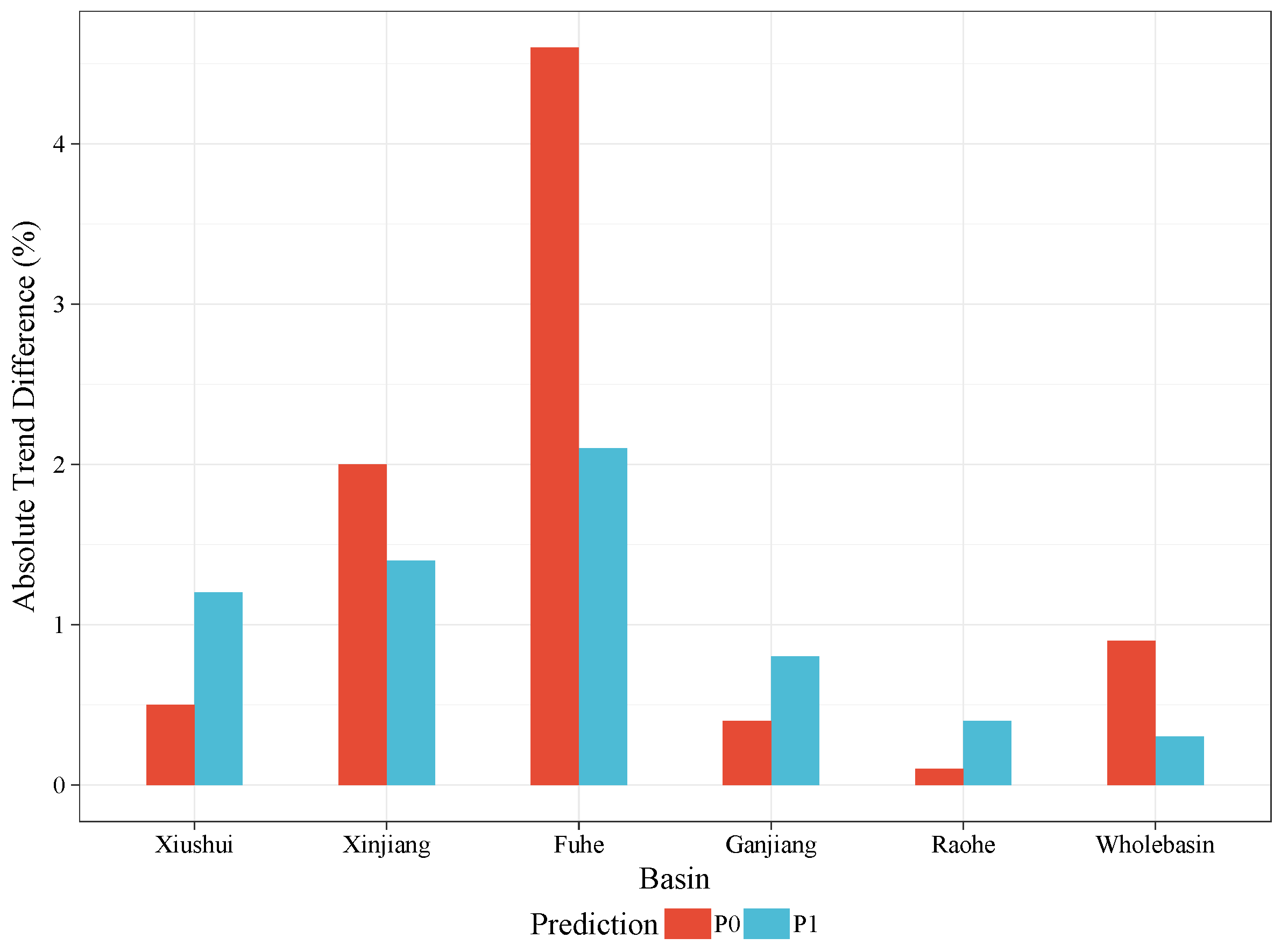

| Study | Research Focus/Considering Catchment Properties Variation or Not | Data/Length of Time Series/Theory | Location/Catchment(s) Analyzed/Size of the Catchment(s) | Key Results on Catchment Properties |
|---|---|---|---|---|
| 1. Yang et al. [21] | the complementary relationship in non-humid environments/(a) | daily data from 238 meteorological stations/1960–2000/Budyko and Penman hypotheses | China/108 catchments/ 272–94,800 km2 | The catchment properties’ parameter has a significant regional pattern and represents the land surface conditions. |
| 2. Yang et al. [22] | relate catchment proprieties parameter to limited landscape characteristics/(a) | daily data from 238 meteorological stations/1951–2000/Budyko hypothesis (Fu’s curve) | China/108 catchments/ 272–94,800 km2 | The catchment properties’ parameter can be estimated from regional characteristics by an empirical formula without calibration |
| 3. Yang et al. [19] | relationships between vegetation coverage and regional water balance/(a) | daily data from 238 meteorological stations/1956–2005/Budyko hypothesis | China/99 catchments/ 272–46,827 km2 | The estimation of the inter annual variability of regional water balance can be improved by considering the inter annual variability of vegetation coverage |
| 4. Yang and Yang [3] | climate elasticity of runoff/(a) | daily data from 238 meteorological stations/1951–2000/ Budyko curve | China/89 catchments/ 272–46,827 km2 | Climate elasticity was sensitive to catchment characteristics |
| 5. Roderick and Farquhar [18] | climate elasticity of runoff/(b) | modeled data [30,31]/1981–2006/ Budyko hypothesis | Australia/Murray Darling Basin/1,060,000 km2 | They gave a qualitative description of why the catchment properties’ parameter will change over time |
| 6. Donohue et al. [4] | precipitation and potential evaporation elasticity/(a) | modeled data [30,31]/1981–2006/ Budyko hypothesis | Australia/Murray Darling Basin/1,060,000 km2 | catchment properties’ parameter varied over the basins without apparent spatial pattern |
| 7. Donohue et al. [29] | to incorporate key ecohydrological processes into Budyko’s hydrological model/(a) | modeled data using BCP model/1981–2006/Budyko hypothesis | Australia/Murray Darling Basin/1,060,000 km2 | The catchment properties’ parameter is closely related to the effects of soil water holding capacity, effective rooting depth and storm depth and could be priori estimated |
| 8. Cong et al. [20] | to understand the hydrological trends in five major basins in China/(b) | daily data from 317 weather stations/1956–2005/Budyko hypothesis | China/5 catchments/ 315,000–1,781,000 km2 | The catchment properties’ parameter is closely related to effective rooting depth and its trend should be taken into account. |
| 9. This study | climate elasticity/(a) and (b) | daily data from 14 meteorological stations/1960–2010/Budyko hypothesis | China/Poyang Lake Basin (PYLB) /162,225 km2 | The catchment properties’ parameter is the dominant factor influencing climate elasticity in PYLB in the past 50 years. |
| Gauging Station | Location | Coordinates | Gauged Area (km2) |
|---|---|---|---|
| Qiujin | Xiushui | 115.41° E, 29.10° N | 9914 |
| Wanjiabu | Liaohe tributary of Xiushui | 115.65° E, 28.85° N | 3548 |
| Waizhou | Ganjiang | 115.83° E, 28.63° N | 80,948 |
| Lijiadu | Fuhe | 116.17° E, 28.22° N | 15,811 |
| Meigang | Xinjiang | 116.82° E, 28.43° N | 15,535 |
| Hushan | Le’an tributary of Raohe | 117.27° E, 28.92° N | 6374 |
| Dufengken | Changjiang tributary of Raohe | 117.12° E, 29.16° N | 5013 |
| Basin | (mm·) | (mm·) | (mm·) | (°C) | (m·) | (%) | (MJ··) |
|---|---|---|---|---|---|---|---|
| Xiushui | 1575.7 | 937.8 | 938.4 | 16.5 | 1.5 | 78.4 | 3101.4 |
| Xingjiang | 1810.2 | 1021.2 | 1151.8 | 18.1 | 2.1 | 76.8 | 3172.0 |
| Fuhe | 1670.8 | 1015.3 | 778.9 | 18.2 | 2.7 | 79.4 | 3197.4 |
| Ganjiang | 1558.7 | 1015.2 | 844.0 | 18.5 | 1.8 | 77.9 | 3214.9 |
| Raohe | 1729.6 | 1001.3 | 1010.0 | 17.6 | 2.0 | 77.1 | 3171.0 |
| Whole basin | 1639.7 | 1001.6 | 894.4 | 17.9 | 2.0 | 77.9 | 3184.9 |
| Basin | ||||||
|---|---|---|---|---|---|---|
| Xiushui | 1.51 | −0.40 | −0.16 | 0.05 | 0.0009 | −0.30 |
| Xinjiang | 1.44 | −0.32 | −0.14 | 0.05 | 0.0010 | −0.27 |
| Fuhe | 2.04 | −0.74 | −0.34 | 0.14 | 0.0029 | −0.15 |
| Ganjiang | 1.65 | −0.50 | −0.21 | 0.07 | 0.0013 | −0.32 |
| Raohe | 1.57 | −0.42 | −0.18 | 0.06 | 0.0012 | −0.26 |
| PYLB | 1.67 | −0.50 | −0.22 | 0.07 | 0.0015 | −0.27 |
© 2017 by the authors. Licensee MDPI, Basel, Switzerland. This article is an open access article distributed under the terms and conditions of the Creative Commons Attribution (CC BY) license ( http://creativecommons.org/licenses/by/4.0/).
Share and Cite
Fan, H.; Xu, L.; Tao, H.; Feng, W.; Cheng, J.; You, H. Accessing the Difference in the Climate Elasticity of Runoff across the Poyang Lake Basin, China. Water 2017, 9, 135. https://doi.org/10.3390/w9020135
Fan H, Xu L, Tao H, Feng W, Cheng J, You H. Accessing the Difference in the Climate Elasticity of Runoff across the Poyang Lake Basin, China. Water. 2017; 9(2):135. https://doi.org/10.3390/w9020135
Chicago/Turabian StyleFan, Hongxiang, Ligang Xu, Hui Tao, Wenjuan Feng, Junxiang Cheng, and Hailin You. 2017. "Accessing the Difference in the Climate Elasticity of Runoff across the Poyang Lake Basin, China" Water 9, no. 2: 135. https://doi.org/10.3390/w9020135
APA StyleFan, H., Xu, L., Tao, H., Feng, W., Cheng, J., & You, H. (2017). Accessing the Difference in the Climate Elasticity of Runoff across the Poyang Lake Basin, China. Water, 9(2), 135. https://doi.org/10.3390/w9020135







